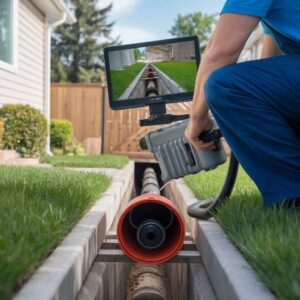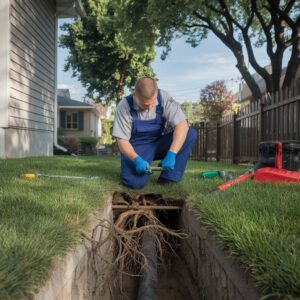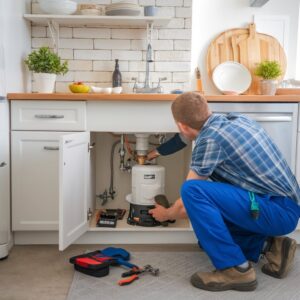Replacing a sump pump requires understanding and recognizing its typical lifespan of 7 to 10 years. Key indicators for replacement include noises, irregular cycling, and basement dampness despite the pump’s activity. Tools needed include an adjustable wrench and a pipe cutter. Verify that the power is off before removal and that proper alignment is performed during installation. Regular inspections and backup systems are essential for ongoing protection. To discover more on the best sump pump installation practices and ensure a seamless replacement, further insights await.
Key Takeaways
- Inspect the sump pump annually, increasing frequency if the pump is older than 7 years, to assess its condition.
- Replace the sump pump if you notice unusual noises, constant operation, or persistent wetness in the basement.
- Gather tools like an adjustable wrench, pipe cutter, and screwdriver set for safe sump pump removal.
- Ensure the new sump pump is correctly positioned, connected, and tested for proper operation and compatibility with your system.
- Test the new sump pump quarterly by filling the sump pit with water to check for proper function and reliability.
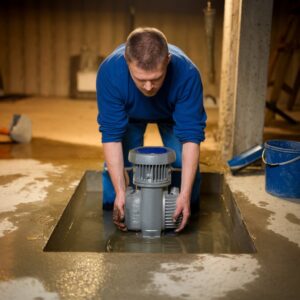
When Should You Replace a Sump Pump?
Determining the ideal time to replace or begin fixing the sump pump involves evaluating factors such as the integrity of the check valve and the frequency of system inspections.
A malfunctioning check valve can lead to backflow, significantly reducing pump efficacy and increasing the risk of flooding.
Regular inspections, ideally conducted annually, are essential to identify problems and ensure the sump pump operates smoothly.
Can a Faulty Check Valve Affect Your Pump?
How does a faulty check valve impact the performance of a sump pump system? A malfunctioning check valve can cause the sump pump to run inefficiently, often increasing water levels in the sump pit.
This occurs when the check valve fails to prevent backflow in the discharge pipe, causing water to return to the pit. Consequently, the pump runs more frequently, which can result in premature wear and potential pump breaks.
Regular check valve inspection is vital to avoid a failing sump pump, especially in older systems.
- Backflow issues: Ineffective prevention of water return.
- Increased pump cycles: Causes the pump to make excess effort.
- Higher water levels: Lead to potential overflow risks.
- System inefficiency: Decreased operational life of the pump.
- Maintenance necessity: Regular checks are essential.
How Often Should You Inspect Your Sump Pump?
When considering the maintenance of a sump pump, evaluating the frequency of inspections becomes paramount to ensuring its ideal operation. Experts recommend inspecting a sump pump at least twice a year. This proactive approach aids in identifying signs of a failing sump, such as unusual noises or decreased efficiency, before water damage ensues.
An old sump pump, typically over seven years old, should be scrutinized more frequently due to a higher likelihood of malfunction. Reviewing the pump’s performance involves checking for blockages and testing its activation.
If the sump pump is still underperforming, it’s time to replace it. Following a sump pump replacement, always test your new sump to confirm it operates at peak efficiency, safeguarding the property.
What are the common signs that you should replace your sump pump?
Spotting early indicators of a sump pump failure helps prevent water damage in your basement.
Common indicators include unusual noises, irregular cycling, and visible rust or corrosion, which may also suggest the need for pipe or valve maintenance.
Typically, a sump pump has an operational lifespan of about 7 to 10 years, after which performance degradation is expected.
How Can You Tell If Your Old Sump Pump Is Failing?
Why do sump pumps fail, and what indicators suggest they need replacement? A sump pump may cease operation due to improper installation or reaching the end of its life, especially if it is an older sump pump.
Essential components like the float switch or impeller may malfunction, causing the sump pump to stop working. Observing a pit with water or a clogged discharge line could indicate a failing system. A power outage could also render the unit inoperative, emphasizing the need to replace the sump pump.
- Frequent cycling or constant operation
- Unusual noises during operation
- Vibrations indicating a damaged impeller
- Visible rust or corrosion on the unit
- Persistent wet basement despite pump activity
Does Your Pipe or Valve Need Attention?
How can one determine if a sump pump’s pipe or valve requires attention?
In evaluating a sump pump system, homeowners should inspect for signs of wear or malfunction. First, examine the outlet pipe. If the PVC pipe or any connecting pipe appears cracked or leaks, replacement may be necessary.
A malfunctioning or old check valve can lead to water backflow into the basement, indicating a need for a new sump pump installation or valve replacement. Listening for unusual sounds from the sump pump can also point towards pipe or valve issues.
If diagnosing these components seems challenging, consulting a professional plumber is advisable. Timely attention to these components can prevent basement flooding and maintain the efficiency of a new sump pump system.
How Long Should a Sump Pump Last?
Attention to the unit’s lifespan is paramount in maintaining a sump pump system. A sump pump typically serves a homeowner for about 10 years. If the pump is over 10 years old, it may be time to replace it with a new one.
Recognizing the signs of a failing primary pump can help guarantee the pump functions at peak performance. An improperly installed sump pump may also prompt premature replacement.
Key indicators suggesting the need to remove the old sump pump include:
- Increased noise levels during operation
- Frequent cycling on and off
- Visible rust or corrosion on the pump
- Irregular or diminished pump performance
- Water accumulation despite pump activation
Proactively monitoring these signs aids in timely sump pump replacement.
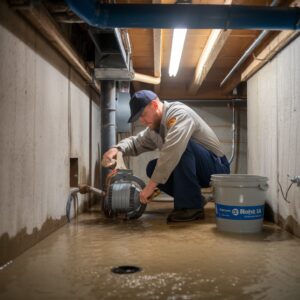
How Do You Remove the Old Sump Pump Safely?
To safely remove an old sump pump, one must gather tools such as a wrench, screwdriver, and bucket.
Proper disconnection of the discharge pipe and check valve prevents water backflow and system damage—an essential part of your Basement Drainage Solutions.
Before removal, it is advisable to pump out standing water using a wet/dry vacuum to guarantee a clean and dry working environment.
What Tools Are Needed to Remove the Old Sump Pump?
Removing an old sump pump requires specific tools to guarantee efficiency and safety, and proper disconnection of the main pump and any associated pipes is vital.
A well-coordinated approach is needed for units like a pedestal pump to handle the PVC connections and clamps. Removal and replacement must be executed precisely, ensuring no damage to the existing setup.
The following tools are essential for the task:
- Adjustable wrench: For loosening and tightening pipe fittings and clamps.
- Pipe cutter: To cleanly cut PVC pipes when necessary.
- Screwdriver set: Essential for disconnecting electrical connections and other fasteners.
- Bucket: To catch any residual water when the pump is removed.
- Pliers: Useful for gripping and twisting stubborn fixtures.
Should You Disconnect the Pipe and Valve First?
Once the necessary tools are in place, attention shifts to the disconnection sequence, beginning with the pipe and valve.
Disconnecting the sump pump from the outlet pipe to the main drain is vital. Carefully plumb and disconnect the check valve, ensuring no residual pressure remains. Following the manufacturer’s instructions is essential to safely replace your pump, as the pump efficiently pushes the water out of the pit.
This step involves loosening the clamps or fittings securing the pipes, avoiding undue force that could damage components. Battery backup options can be considered during installation to ensure continuous operation during power outages. Ensure the pump is installed correctly and the switch is not too high to allow proper activation.
Once disconnected, the old pump can be safely removed, allowing the new pump to be installed and ensuring the system remains efficient and reliable.
How Do You Pump Water Out Before Replacement?
Before replacing a sump pump, removing any standing water from the sump pit is vital to prevent flooding and facilitate a safer working environment. This task requires using a temporary utility pump to pump water out efficiently. The process guarantees that any water in the sump is fully evacuated before disconnecting the broken sump pump.
Proper equipment and steps are significant, particularly in a basement or crawlspace. Confirm that the pump to turn on is securely connected and operational. Use hose clamps to attach the discharge hose, directing water away from the foundation.
Prepare to replace the sump pump by:
- Confirm that the power is off to the existing unit.
- Setting up a utility pump for water removal.
- Using hose clamps on the discharge hose.
- Installing a pipe to the new pump.
- Verifying the new unit’s compatibility.
How Do You Install a New Sump Pump?
Installing a new sump pump begins with positioning it in the sump pit, ensuring it is level and secure.
Connect the discharge pipe to the pump, sealing the joints with PVC cement to prevent leaks, and test the check valve to confirm proper flow direction.
Regular maintenance, such as cleaning the pump and testing the float switch, is essential for extending the lifespan of the sump pump and ensuring operational efficiency.
Steps for Installing Your New Sump Pump
To install a new sump pump effectively, one must first confirm that all necessary tools and materials, such as a new pump, PVC pipes, a check valve, and pipe fittings, are readily available.
When replacing a sump pump, determine if a pedestal sump pump or a submersible pump is required. Ascertain that the pump sits properly at the top of the sump. Securely screw it into the fitting to prevent leaks.
A sump pump can help prevent basement flooding. If the pump needs to be replaced, a battery backup system is advisable for uninterrupted operation.
- Verify pump type: Pedestal or submersible.
- Position the pump: Ensure it sits correctly.
- Connect pipes: Securely screw into fittings.
- Install a check valve for backflow prevention.
- Consider battery backup for emergencies.
How Can You Maintain Your Pump for Long Life?
Proper sump pump maintenance is essential for guaranteeing its longevity and ideal performance.
Regular inspections are pivotal to identifying signs of wear that may cause your pump to fail prematurely. Testing the sump pump quarterly by pouring water into the sump pit to confirm activation is advisable.
Maintaining a backup pump or installing a battery backup system can protect against power outages or primary pump failures. A sump pump may require replacement if it exhibits reduced efficiency or unusual noises.
Cleaning the pump and discharge pipe of debris can prevent clogs. Confirming that the float switch operates correctly is critical, as a malfunction can compromise the system.
Understanding your pump needs allows you to maintain a new system effectively.
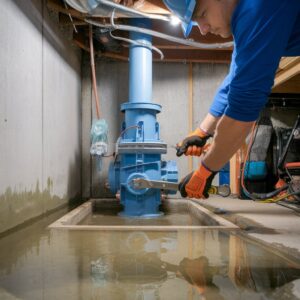
How Can You Ensure a Smooth Sump Pump Replacement?
To guarantee a seamless sump pump replacement, it is essential first to disconnect the power supply and secure the work area to prevent hazards during the removal of the old pump, especially if your pump has stopped working.
Before starting, consider the type of sump pump you are installing, as sump pumps come in different models and sizes. Once the new pump is in place, perform a thorough test by simulating water flow to ensure the pump operates correctly and effectively keeps your basement dry.
Understanding the range of sump pumps available helps determine whether you need to replace or maintain your sump. Monitoring the system’s performance is recommended to detect any issues early and guarantee longevity.
What Precautions Should You Take Before Removing the Old Pump?
Several vital precautions must be taken before removing an old sump pump to guarantee a seamless replacement process. Proper attention to safety and procedure minimizes potential issues in the basement environment.
It is essential to assess and stabilize the water level before proceeding with the replacement. Ensuring that power to the sump pump is shut off is essential to prevent electrical hazards. Disconnecting the discharge line is another key step in safely removing the old pump.
Implementing these steps with care will facilitate an efficient shift to the new system.
- Shut off power to the sump pump to avoid electrical shocks.
- Assess and stabilize the water level in the sump pit.
- Disconnect the discharge line gently.
- Ensure the work area is dry to prevent slips.
- Use appropriate personal protective equipment for safety.
How Do You Test and Monitor the New Sump Pump?
Upon replacement with a new unit, a thorough test involves filling the sump pit with water to activate the float switch. Ensure the switch is not too high so the sump pump protects your basement effectively and ensures the pump properly discharges.
Monitoring the horsepower pump in a basement environment includes checking for consistent operation during heavy rainfall, particularly observing the pump’s activation frequency.
To enhance reliability, install a battery backup system; this guarantees operation amid power outages. Regularly inspect connections and listen for unusual noises, indicating potential mechanical issues. An automated sump pump monitor can provide alerts and status updates, ensuring your new unit continues to operate efficiently.
Conclusion
Maintaining a functional sump pump prevents basement flooding and water damage. Recognizing when to replace a sump pump involves monitoring for signs such as unusual noises, frequent cycling, or decreased efficiency. Safely removing the old unit and installing a new one requires careful handling of electrical connections and plumbing. Ensuring a seamless replacement process involves selecting an appropriately sized pump and conducting periodic maintenance checks to extend its lifespan and reliability.



